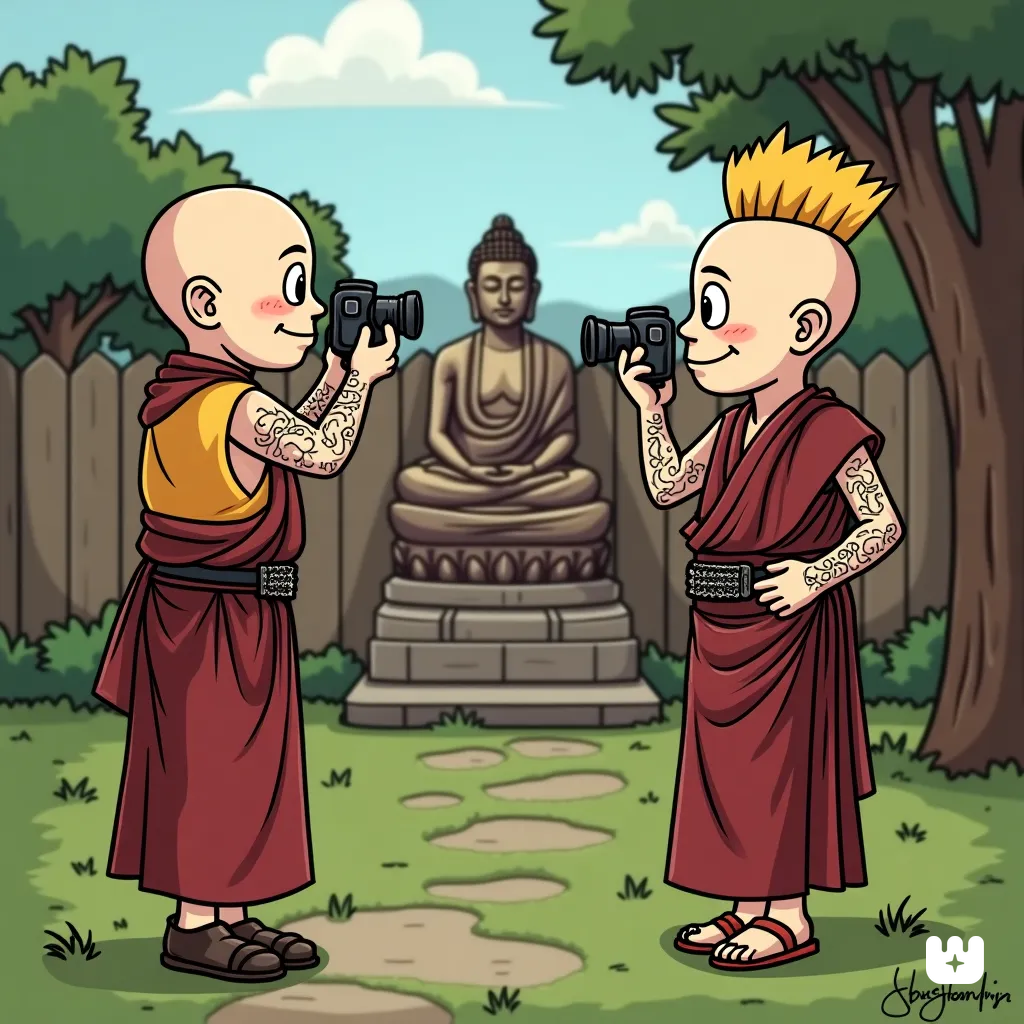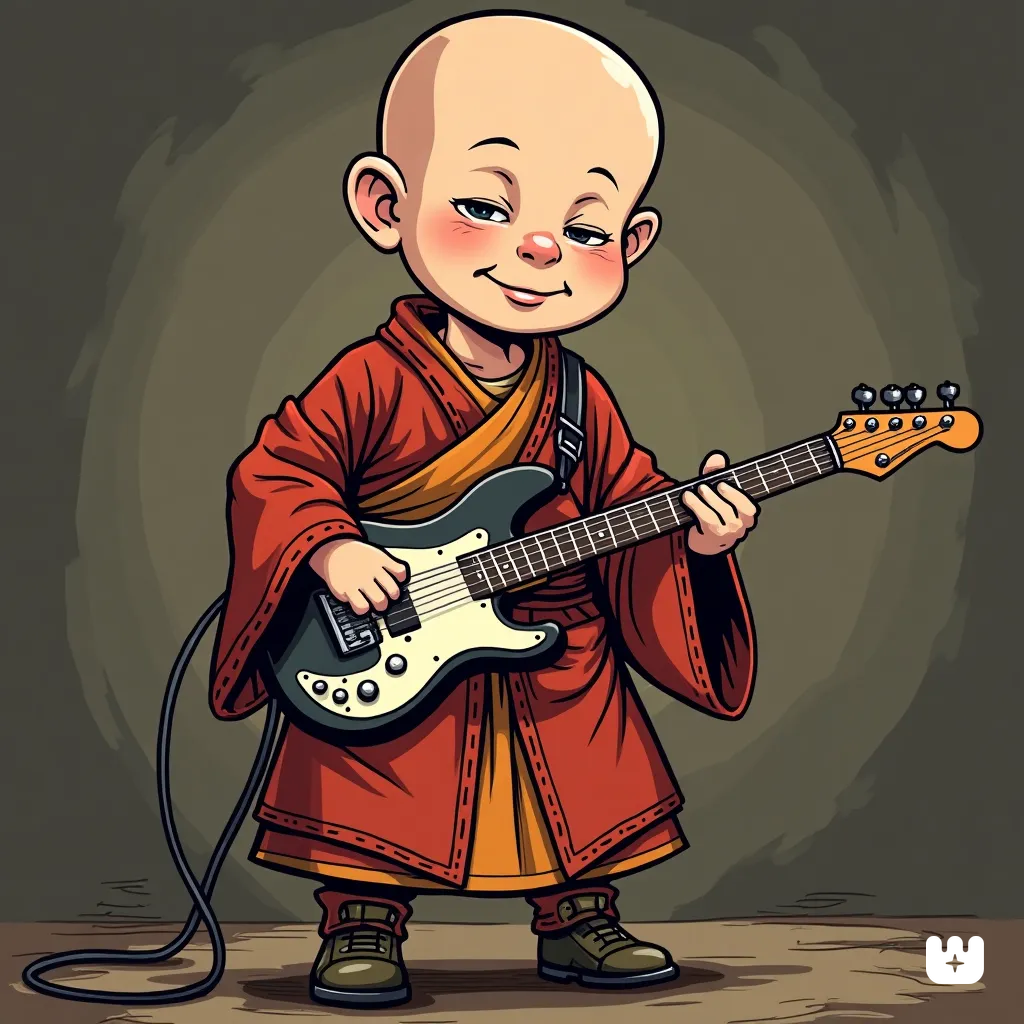Breathtaking images of various Buddhas throughout history are as ubiquitous as The Dharma itself. The immense Leshan Giant Buddha in Sichuan China, the stunning Great Buddha of Thailand, and… the four inch tall Buddha featured on the cover of Blink-182’s demo cassette “Buddha“? While not as awe-inspiring or magnificent as some other imagery of the Buddha, the cover of Blink-182s Buddha has sparked enough discussion and arguments to rival the length of the Tripitaka in full. Why did Blink-182 name their debut album after the Buddha? Is there any significance to the name? We’re taking a deep dive to uncover the lore behind The Buddha.
A Brief History of Blink-182’s “Buddha”
Blink-182’s album “Buddha” (1994) is a collection of raw, early pop-punk demos recorded at Doubletime Studios rather than a fully polished album. It was the band’s first recording to be sold and distributed. There’s a lot debate as to whether or not it’s actually their first album among fans, despite Mark Hoppus himself stating he counts it as the first. The demo was originally released on the label Filter Records by Pat Secor, close friend of Hoppus. Unfortunately, the album spurred a legal dispute between the band and Secor in later years. The band accusing Secor of selling the tape without paying royalties. The feud escalated to the group hiring lawyer Joe Escalante of the Vandals to represent them. Escalante would later remix and remaster the album on his own label Kung Fu Records in 1998, leading to 300,000 physical copy sales and mainstream success.

The Six Degrees of Separation of Mark, Tom and Scott
Buddhism is the “six degrees of Kevin Bacon” of religions. You can find a connection in anything if you look deep enough. Despite the title and cover artwork, the lyrics on Blink-182’s Buddha don’t explicitly reference Buddhist philosophy, enlightenment, or mindfulness. The album mostly focuses on themes like teenage angst, relationships, and humor. It’s an embodiment of early Blink-182 style and humor.
However, if you stretch it a bit, you could find some unintentional Buddhist-adjacent themes, like:
Impermanence (Anicca) And Mindfulness
Mindfulness is the concept of paying attention to the current moment without judgement. It’s the practice of cultivating a state of full awareness where one is engaged in the present, without getting caught up in past or future thoughts or emotions. Most Buddhist sects and teachings regard time as a relative truth. It’s a human construct that many forms of meditation strive to see past. Most importantly, each moment is fleeting and impermanent. We hear the band inadvertently recognize the suffering that its caused by latching on to each specific moment in their song “Time“.
And I don’t want to worry
About being on time
(I see) I see the way you hurry
And time runs your life again…
I wish that Earth clock
Could often just be stopped
And then we look into the time
Blink-182 writes songs for teenagers, drummer Scott Raynor even was a teenager at the time of recording. As such, many songs deal with fleeting relationships and growing up, which align with the Buddhist idea that everything is temporary and impermanent. The formative teenage years mark the first time many people confront the complexity of time and loss. It’s a time of going off to college, getting your first job and letting go of your childhood.
Time takes on a new meaning. It doesn’t just represent new, exciting change. But also difficult change. During this time, you must let go of things and people and confront the impermanence of everything. The lyrics show how difficult that can be and the desire to pause time to create permanence. You can see the suffering or unsatisfactoriness caused by the band’s desire to hold on to the moments or their wish for “that Earth clock to be stopped.”
Suffering (Dukkha)
Music is a vehicle for expressing your emotions. Whether they be happiness, fear or more commonly in the pop-punk world, angst. The first Nobel Truth is The Truth of Suffering or “Dukkha”. Life is marked by the existence of suffering or, as it’s sometimes referred to, unsatisfactoriness. It’s all pervasive, which makes it easy to find in Mark and Tom’s lyrics. In their song “21 Days” Tom sings:
My mind wanders as I’m trying not to fall in love with you
‘Cause every time I wake, I ponder on my mistakes
Although he may may not have been aware of it Tom Delonge is acknowledging the First Noble Truth. Whenever he is conscious and experiencing life, he fixates on his past and mistakes he made. This causes suffering. The Buddha first recognized suffering as old age, sickness and death. He later expanded this definition to acknowledge human desires and cravings, like those for the past, and how they impact our sense of fulfillment. Even when we are not suffering from outward causes like illness or bereavement, we are unfulfilled and unsatisfied when we hold onto the past. This is the truth of suffering. In Tom’s lyrics he touches upon the impermanence and craving of the past or, as he puts it, “pondering on his mistakes”.
Non-Attachment
The Buddha’s concept on Non-Attachment is centered on letting go of our attachment to material possessions, relationships, and even our thoughts and emotions. Tom DeLonge once again unwittingly sings some Buddhist wisdom and realizes how the buddhist concept of non-attachment could ease his suffering in the song “Carousel“:
I need a job just to sleep in sheets
Buying food every once in a while
But not enough to purchase a smile
A tank of gas is a treasure to me
I know now that nothing is free
Tom acknowledges he needs a job and money for shelter and a safe place to sleep at night. He recognizes his need to buy food, but also notes that there isn’t happiness or fulfillment in the over-processed, unhealthy fast food he’s consuming in this subtle jab at the McDonalds “Purchase a smile” ad campaign. A tank of gas is a treasure, but also a great metaphor for the kind of happiness material goods bring us. Like a tank of gas, satisfaction doesn’t last forever; as soon as you start using it, you must replenish it with other material goods. The last line is the most powerful. When your fulfillment is based on material goods and fleeting objects nothing is free. The suffering caused by attachment is on full display.

The Uninspiring Story Behind The Naming of Blink-182’s Buddha
Detail oriented Buddhists who happen to be Blink-182 fans have probably already noticed that this album named Buddha doesn’t feature a picture of Shakyamuni Buddha. The cover art on the original 90s cassette shows an image of Budai, a Chinese monk named Qieci venerated as the future or Maitreya Buddha in Chan Buddhism. This legendary image was captured by friend of the band Cam Jones. It was one of many “artsy” images taken in drummer Scott Raynor’s backyard.
Hoppus’ stepfather gave him the statue as a gift earlier that year. He quickly grabbed the statue on the way out the door to meet Jones for the photo shoot. There’s no great meaning behind the statue or album title. The band simply thought it looked “artistic” and decided to run with it. It’s the result of Jones and Hoppus setting out with the intention to take “artsy” photos then having those photos developed and making a collage of them. It’s nothing more than a coincidence spurred by one mans last minute decision that a certain decoration looked artistic. The cover and title could have been one of the other props they brought or items in Raynor’s backyard that day but, due to a quick impulse, ended up being an image of The Buddha. Disappointingly, there’s nothing more to it.

